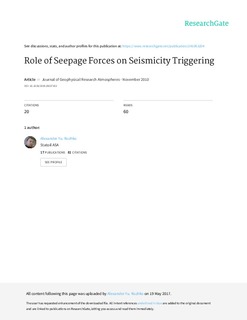Role of Seepage Forces on Seismicity Triggering
Journal article, Peer reviewed
Published version
Permanent lenke
http://hdl.handle.net/11250/2646045Utgivelsesdato
2010-11Metadata
Vis full innførselSamlinger
Originalversjon
Rozhko, A.Y. (2010) Role of Seepage Forces on Seismicity Triggering. Journal of Geophysical Research - Solid Earth, 115(B11) 10.1029/2009JB007182Sammendrag
Borehole fluid injection is commonly used for geological sequestration of carbon dioxide, underground storage of natural gas, waste injections, and during stimulations and development of geothermal and hydrocarbon reservoirs. Typically, the injection process induces significant seismicity, with some earthquakes as large as magnitude four. Induced seismicity has also been observed around producing hydrocarbon boreholes. Recently, it has been argued that some induced seismicity data can be explained by a highly nonlinear fluid diffusion mechanism or by the propagation of fluid pressure pulses. The nature of the nonlinearity and the mechanisms by which a pressure pulse can trigger seismicity are still uncertain. In this paper I show that the same spatiotemporal variation of seismicity can be explained and predicted by linear diffusion coupled to deformation of a linear poroelastic medium. By calculating the propagation of Coulomb Yielding Stress (CYS) perturbation with time, it is demonstrated that seismicity can be triggered by this perturbation. The change of CYS along the diffusion front is caused by seepage forces, which are body forces generated by fluid pressure gradients, and can explain induced seismicity during borehole fluid injection and extraction. Using published experimental data, I demonstrate how the spatiotemporal distribution of fluid‐induced seismic events can be used for reservoir modeling and characterization.
